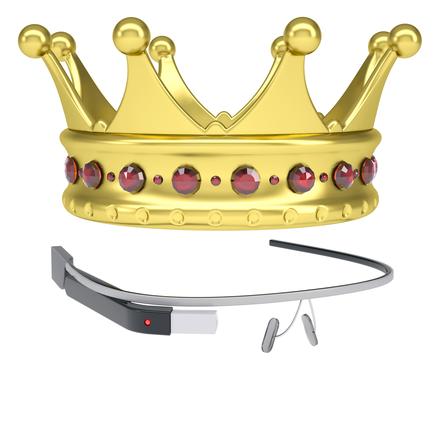Smartglasses should be part of BYOD policies: Gartner
- 08 November, 2013 11:11

Gartner says the use of smartglasses has the potential to improve worker efficiency in vertical markets such as manufacturing, field service, retail and healthcare.
"Smartglasses with augmented reality (AR) and head-mounted cameras can increase the efficiency of technicians, engineers and other workers in field service, maintenance, healthcare and manufacturing roles," says Gartner research director Angela McIntyre.
"In the next three to five years, the industry that is likely to experience the greatest benefit from smartglasses is field service, potentially increasing profits by US$1 billion annually. The greatest savings in field service will come from diagnosing and fixing problems more quickly and without needing to bring additional experts to remote sites."
Smartglasses still remain an emerging technology in the enterprise and less than 1 per cent of companies in the US have implemented smartglasses, although Gartner predicts that may increase to 10 per cent during the next five years for companies with offsite workers, such as field service personnel and inspectors.
"IT organisations are already being asked to make recommendations about whether smartglasses should be used in the workplace based on benefits and risks perspective, as well as policy and implementation," says McIntyre.
"Now is the time for IT organisations to refresh their bring-your-own-device (BYOD) policies with smartglasses in mind. Though IT organisations will provide smartglasses to employees who regularly wear them for their job task, much of the IT impact may come from employees wearing their personal smartglasses at work."
"Now is the time for IT organisations to refresh their bring-your-own-device (BYOD) policies with smartglasses in mind.
The analyst firm says the introduction of lower-priced, consumer versions of smartglasses will further help adoption such that in 10 years, perhaps half the companies that would benefit from using smartglasses will give them to at least some of their employees who could make use of them.
Adoption of smartglasses will be slow because the benefits they provide depend heavily on the apps and services targeted at smartglasses. However, during the next five years, the ecosystems will evolve to include more apps that do specific tasks with smartglasses, which may cause IT organisations to provide them for a wider range of employees.
Smartglasses are expected to have the most impact on heavy industry, such as manufacturing, and oil and gas, because the AR glasses enable on-the-job training of workers in how to fix equipment and perform manufacturing tasks. The impact is likely to be medium for mixed industries, such as retail, consumer packaged goods and healthcare, where the benefits may mostly be looking for information via a visual search.
The 'weightless industries', such as insurance, media and banking will likely experience a low impact from smartglasses. However, there are still potentially beneficial uses for smartglasses. Insurance agents, for example, may use smartglasses to video property that has been damaged and then check on the replacement value of items they have identified using a visual search. Financial institutions and the media will use smartglasses to deliver alerts via subscription services for smartglasses to professionals who need up-to-the-minute information.
Gartner expects some of the basic functions of smartglasses to help bring added efficiency to the enterprise. How-to instructions and illustrations on the smartglass displays enable workers to perform tasks even if they do not remember all the procedures. The virtual assistant on the smartglasses could serve as an interactive, hands-free "how-to" manual. Thus, workers may successfully complete tasks they have little experience doing. In addition, workers with mild memory issues or cognitive impairment may find smartglasses useful tools for remembering how to complete tasks.
Video collaboration with experts in remote locations results in faster repairs and saves the expense of flying an expert to the site to help. Employees at remote sites can communicate and share video of what they see with experienced workers to get advice on how to diagnose and fix problems. In this way, enterprises can improve the cost-effectiveness of their field service and remote operations by employing a larger ratio of less-experienced workers to experienced ones or specialists, thus saving labour costs.
The streamed video can be stored as evidence that a job was performed correctly or that everything looks fine during an inspection. Such video records can be valuable if customers make allegations against the field service company. The video record is important for other industries as well, notably insurance adjusters, real estate appraisers, construction inspectors and couriers to prove package delivery.
"Given these advances, the goals of corporate training may evolve away from memorising procedural steps to knowing how to use smartglasses and access key information using voice commands," says Tuong Nguyen, principal research analyst at Gartner. "Classroom training and tests on the content of manuals can be reduced since much of the practical training can be done 'on the job' with the assistance of smartglasses. However, training must always include safety and employees should continue to know how to use equipment for routine tasks."
For the healthcare industry, smartglasses would facilitate telemedicine and expert consultations with doctors in a different locale, and they would serve as a how-to guide for performing medical procedures. Smartglasses could streamline the patient experience at the doctor's office. Patients could opt-in to have their face in their doctor's database. The electronic medical records of the patient would be ready for the doctor as soon as facial recognition identifies the patient.
Follow CIO New Zealand on Twitter:@cio_nz
Sign up for CIO newsletters for your regular updates on CIO news, views and events.

